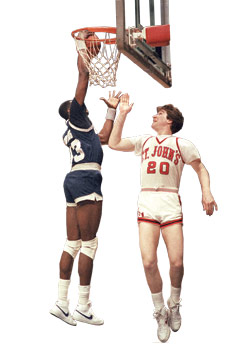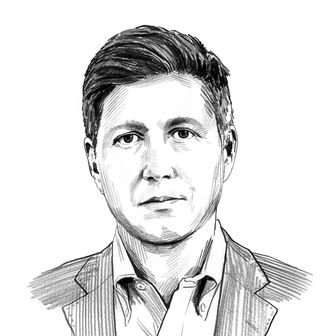
The consensus, which happens to be correct, is that this year’s Big East Tournament at Madison Square Garden marks the passing of an era, as marquee program Syracuse prepares to bolt for the ACC, with UConn contemplating its own departure; what’s left of the league will reportedly split into multiple conferences over the summer. But the end has been long in the making. The dominance of football and the flood of TV money have scrambled college athletics’ old hierarchies, and the Big East has been one of the victims; last year, its tournament title game was a dreary 50-44 contest between noted Eastern Seaboard schools Louisville and Cincinnati, for crying out loud. There was a stretch, though, from 1983 to 1986, when the event produced some all-time great sports moments.
The Big East Tournament took up residence at the Garden at the exact perfect time. Nationally, 1983 was the year of North Carolina State and Jim Valvano’s frantic search for someone to hug, but college hoops at its best was happening in New York City. Nineteen eighty-three was when Chris Mullin won the Big East Player of the Year award as a sophomore and led St. John’s to a league championship at the Garden. He was joined by Georgetown’s Patrick Ewing, and the two stars became the headline act of a golden age for NCAA basketball. Ewing was the monstrous physical presence the game hadn’t seen since Wilt Chamberlain—one of the first freshmen to immediately be the best player on his team, overpowering yet agile. Mullin was the gym-rat Catholic kid who worshiped Larry Bird and had traversed the city as a teenager, expanding his game. They would be teammates on the 1984 gold-medal-winning Olympic team. But the Big East Tournament was the best place to watch them.
And not just them: The tourney also featured legends like Villanova’s Ed Pinckney; Syracuse’s Leo Rautins, Sherman Douglas, and Pearl Washington; and St. John’s Mark Jackson, mentored by larger-than-life coaches like the imposing John Thompson, the bespectacled Jim Boeheim, and the be-sweatered Lou Carnesecca. College recruiting was just then going national, so the talent was homegrown, and it was also before top prospects jumped straight to the pros (or spent a mandatory year in NCAA). Players stayed and developed their games and their rivalries.
Those mid-eighties Big East Tournaments produced classic games: Ewing getting the best of Mullin in the 1985 final (and then again in that year’s NCAA semifinals, which also featured Villanova, the last time a Final Four has had three teams from the same conference). Walter Berry’s block of Washington’s layup in the final seconds gave St. John’s the 1986 title. But the magic couldn’t last. There have been reports that the majority of the league’s Catholic universities will in coming weeks form a smaller conference that will keep the Big East name alive. But it won’t really be the Big East. The Big East is Chris Mullin and Patrick Ewing, and all that can never be again.
Have good intel? Send tips to intel@nymag.com.
